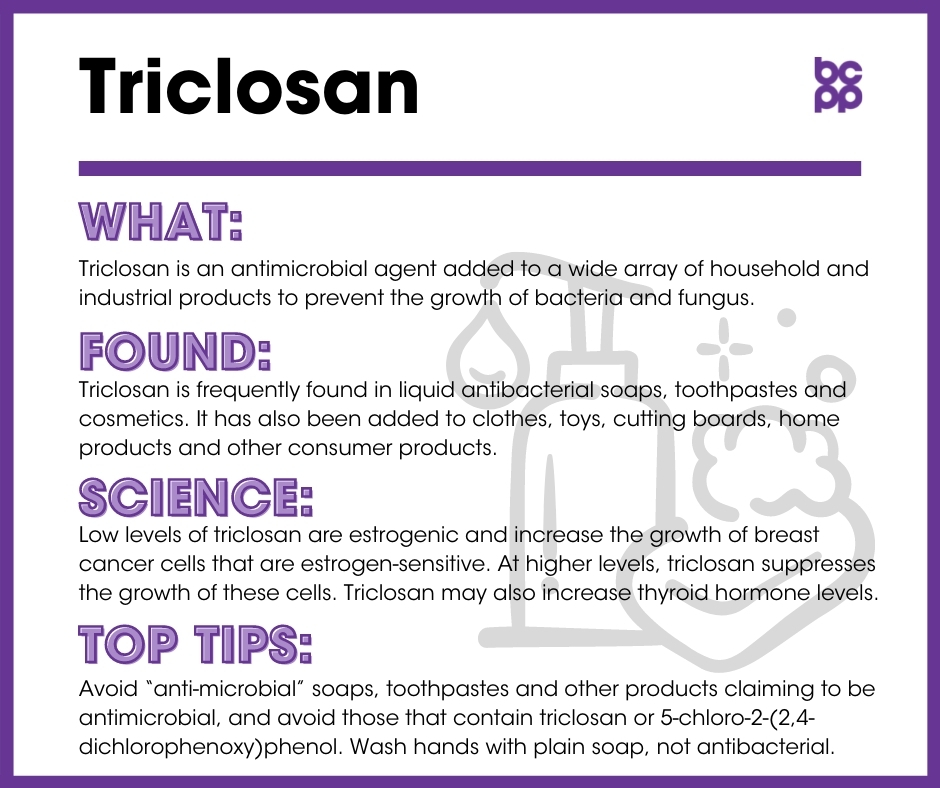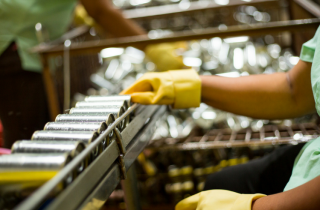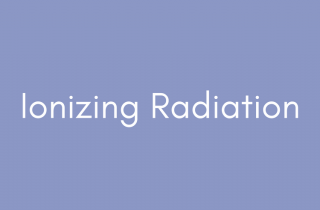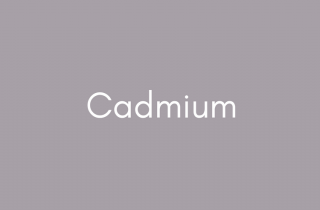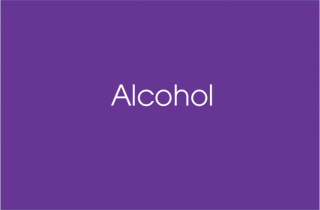Triclosan
At a Glance
Triclosan is an antimicrobial agent added to a wide array of household products to prevent the growth of bacteria and fungus. It has been found in human blood, urine and breast milk.
The chemical is a potential endocrine disruptor in humans. It can also have negative impacts on environmental health, including aquatic systems.
What is triclosan?
Triclosan is an antimicrobial agent that is added to household and industrial products to prevent bacterial and fungal growth.[1] Triclosan’s chemical structure has striking similarities to thyroid hormones[2] and to several known endocrine disruptors including diethylstilbestrol (DES) and bisphenol A (BPA).[3] Triclosan will be listed as an active ingredient on any product label, since it is considered a pesticide.
Where is triclosan found?
Triclosan is frequently found in liquid antibacterial soaps,[4] toothpastes and cosmetics.[5],[6] It has also been added to clothes, toys, cutting boards, home products and other consumer products,[7] although some states are beginning to ban its use.[8] The majority of triclosan in products ends up washed down the drain.[9] After wastewater treatment, triclosan can accumulate in sewage sludge, which, if used for fertilizer, can end up absorbed by plants, including food crops.[10],[11],[12]
What evidence links triclosan to breast cancer?
Limited research suggests triclosan can be both estrogenic and anti-estrogenic.[13] Recent reviews suggest that at low levels triclosan is estrogenic, because at low levels it increases the growth of breast cancer cells that are estrogen-sensitive. At higher levels, triclosan suppresses the growth of these cells, suggesting that larger amounts may have an anti-estrogenic effect.[14],[15],[16]
The effects of triclosan on breast cancer cells in vitro may depend on dose and the presence of other factors, such as estradiol (natural estrogen). [17],[18],[19] Possible health effects include a smaller head circumference at birth,[20] early breast development,[21] antibiotic resistance [22] and allergies.[23]
Triclosan may also disrupt the endocrine system by increasing thyroid hormone levels.[24] High levels of thyroid hormones may predict breast cancer risk. Although no direct link has been established, thyroid dysfunction occurs more frequently in breast cancer patients compared to healthy individuals.[25]
Who is most likely to be exposed to triclosan?
A study looking at a representative sample of the U.S. population found that 75 percent of participants had triclosan in their urine. Higher concentrations were found in young adults and more affluent adults.[26] Another study has found higher levels of triclosan in females compared to males.[27]
Triclosan has also been detected in liver and adipose tissue,[28] although it does not appear to bioaccumulate.[29]
Who is most vulnerable to the health effects of triclosan?
Triclosan exposure is of concern at critical periods of development, including prenatal development, puberty and pregnancy. Since it is a potential endocrine disruptor, there is concern that triclosan may have the most profound effects during these windows of vulnerability.[30]
What are the top tips to avoid exposure to triclosan?
- Become a label reader. Avoid “anti-microbial” soaps, toothpastes and other products claiming to be antimicrobial and containing triclosan or 5-chloro-2-(2,4-dichlorophenoxy)phenol.
- Wash your hands with plain soap and warm water. Antibacterial soaps are no more effective than plain soap for killing germs for everyday activities.[31]
- Peel your carrots and other root vegetables or buy organic. Vegetables (especially the outer layer of roots) may be contaminated if sewage sludge is used as a fertilizer.[32]
Reviewed 2019
[2] Koeppe, Erika S et al. “Relationship between urinary triclosan and paraben concentrations and serum thyroid measures in NHANES 2007-2008.” The Science of the Total Environment 445-446 (2013): 299-305. doi:10.1016/j.scitotenv.2012.12.052.
[3] Ahn, Ki Chang et al. “In vitro biologic activities of the antimicrobials triclocarban, its analogs, and triclosan in bioassay screens: receptor-based bioassay screens.” Environmental Health Perspectives 116, 9 (2008): 1203-10. doi:10.1289/ehp.11200.
[4] Perencevich, E N et al. “National and regional assessment of the antibacterial soap market: a step toward determining the impact of prevalent antibacterial soaps.” American Journal of Infection Control 29, 5 (2001): 281-3. doi:10.1067/mic.2001.115469.
[5] National Center for Biotechnology Information. “PubChem Compound Summary for CID 5564, Triclosan” PubChem, https://pubchem.ncbi.nlm.nih.gov/compound/Triclosan. Accessed 14 November, 2020.
[6] Dinwiddie, Michael T et al. “Recent evidence regarding triclosan and cancer risk.” International Journal of Environmental Research and Public Health 11, 2 (2014): 2209-17. doi:10.3390/ijerph110202209.
[7] Halden, Rolf U. “On the need and speed of regulating triclosan and triclocarban in the United States.” Environmental Science & Technology 48, 7 (2014): 3603-11. doi:10.1021/es500495p.
[8] Chow, Lorriane. “This State Banned a Very Common Ingredient Hiding in Your Soap.” Nation Swell May 22, 2014. http://nationswell.com/minnesota-bans-triclosan-hand-sanitizer/
[9] Dann, Andrea B, and Alice Hontela. “Triclosan: environmental exposure, toxicity and mechanisms of action.” Journal of Applied Toxicology 31, 4 (2011): 285-311. doi:10.1002/jat.1660.
[10] Halden, Rolf U. “On the need and speed of regulating triclosan and triclocarban in the United States.” Environmental Science & Technology 48, 7 (2014): 3603-11. doi:10.1021/es500495p.
[11] Macherius Andre et al. “Uptake of galaxolide, tonalide, and triclosan by carrot, barley, and meadow fescue plants.” Journal of Agricultural and Food Chemistry 60, 32 (2012): 7785-7791. doi:10.1021/jf301917q.
[12] Blackwell, B. R. et al. “Uptake of 17β-trenbolone and subsequent metabolite trendione by the pinto bean plant (Phaseolus vulgaris).” Ecotoxicology and Environmental Safety 85 (2012): 110–114. doi:10.1016/j.ecoenv.2012.08.006.
[13] Henry, Natasha D, and Patricia A Fair. “Comparison of in vitro cytotoxicity, estrogenicity and anti-estrogenicity of triclosan, perfluorooctane sulfonate and perfluorooctanoic acid.” Journal of Applied Toxicology 33, 4 (2013): 265-72. doi:10.1002/jat.1736.
[14] Dinwiddie, Michael T et al. “Recent evidence regarding triclosan and cancer risk.” International Journal of Environmental Research and Public Health 11, 2 (2014): 2209-17. doi:10.3390/ijerph110202209.
[15] Yueh, Mei-Fei, and Robert H Tukey. “Triclosan: A Widespread Environmental Toxicant with Many Biological Effects.” Annual Review of Pharmacology and Toxicology 56 (2016): 251-72. doi:10.1146/annurev-pharmtox-010715-103417.
[16] Ajao, Charmaine et al. “Mitochondrial toxicity of triclosan on mammalian cells.“ Toxicology Reports 2 (2015): 2624-637. doi:10.1016/j.toxrep.2015.03.012.
[17] Gee, R H et al. “Oestrogenic and androgenic activity of triclosan in breast cancer cells.” Journal of Applied Toxicology 28, 1 (2008): 78-91. doi:10.1002/jat.1316.
[18] Liu, Binqiu et al. “Triclosan inhibits enoyl-reductase of type I fatty acid synthase in vitro and is cytotoxic to MCF-7 and SKBr-3 breast cancer cells.” Cancer Chemotherapy and Pharmacology 49, 3 (2002): 187-93. doi:10.1007/s00280-001-0399-x.
[19] Henry, Natasha D, and Patricia A Fair. “Comparison of in vitro cytotoxicity, estrogenicity and anti-estrogenicity of triclosan, perfluorooctane sulfonate and perfluorooctanoic acid.” Journal of Applied Toxicology 33, 4 (2013): 265-72. doi:10.1002/jat.1736.
[20] Lassen, Tina Harmer et al. “Prenatal Triclosan Exposure and Anthropometric Measures Including Anogenital Distance in Danish Infants.” Environmental Health Perspectives 124, 8 (2016): 1261-8. doi:10.1289/ehp.1409637.
[21] Wolff, Mary S et al. “Environmental phenols and pubertal development in girls.” Environment International 84 (2015): 174-80. doi:10.1016/j.envint.2015.08.008.
[22] Schweizer, H P. “Triclosan: a widely used biocide and its link to antibiotics.” FEMS Microbiology Letters 202, 1 (2001): 1-7. doi:10.1111/j.1574-6968.2001.tb10772.x.
[23] Bertelsen, R J et al. “Triclosan exposure and allergic sensitization in Norwegian children.” Allergy 68, 1 (2013): 84-91. doi:10.1111/all.12058.
[24] Koeppe, Erika S et al. “Relationship between urinary triclosan and paraben concentrations and serum thyroid measures in NHANES 2007-2008.” The Science of the Total Environment 445-446 (2013): 299-305. doi:10.1016/j.scitotenv.2012.12.052.
[25] Heublein, Sabine et al. “Thyroid hormone receptors predict prognosis in BRCA1 associated breast cancer in opposing ways.” Plos ONE 10, 6 (2015): 1-19. doi:10.1371/journal.pone.0127072.
[26] Calafat, Antonia M et al. “Urinary concentrations of triclosan in the U.S. population: 2003-2004.” Environmental Health Perspectives 116, 3 (2008): 303-7. doi:10.1289/ehp.10768.
[27] Koeppe, Erika S et al. “Relationship between urinary triclosan and paraben concentrations and serum thyroid measures in NHANES 2007-2008.” The Science of the Total Environment 445-446 (2013): 299-305. doi:10.1016/j.scitotenv.2012.12.052.
[28] Geens, Tinne et al. “Distribution of bisphenol-A, triclosan and n-nonylphenol in human adipose tissue, liver and brain.” Chemosphere 87, 7 (2012): 796-802. doi:10.1016/j.chemosphere.2012.01.002.
[29] Dinwiddie, Michael T et al. “Recent evidence regarding triclosan and cancer risk.” International Journal of Environmental Research and Public Health 11, 2 (2014): 2209-17. doi:10.3390/ijerph110202209.
[30] Interagency Breast Cancer and Environmental Research Coordinating Committee. “Breast Cancer and the Environment. Prioritizing Prevention.” February 2013. http://www.niehs.nih.gov/about/assets/docs/ibcercc_full_508.pdf.
[31] Kim, S A et al. “Bactericidal effects of triclosan in soap both in vitro and in vivo.” The Journal of Antimicrobial Chemotherapy 70, 12 (2015): 3345-52. doi:10.1093/jac/dkv275.
[32] Macherius Andre et al. “Uptake of galaxolide, tonalide, and triclosan by carrot, barley, and meadow fescue plants.” Journal of Agricultural and Food Chemistry 60, 32 (2012): 7785-7791. doi:10.1021/jf301917q.

